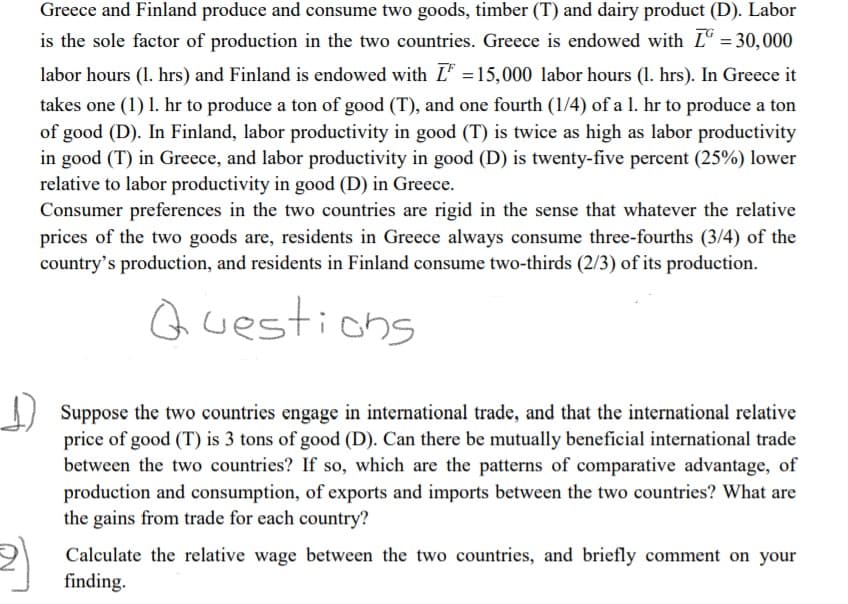Greece and Finland produce and consume two goods, timber (1) and dairy product (D). Labor is the sole factor of production in the two countries. Greece is endowed with Lº =30,000 labor hours (1. hrs) and Finland is endowed with L =15,000 labor hours (1. hrs). In Greece it takes one (1) 1. hr to produce a ton of good (T), and one fourth (1/4) of a 1. hr to produce a ton of good (D). In Finland, labor productivity in good (T) is twice as high as labor productivity in good (T) in Greece, and labor productivity in good (D) is twenty-five percent (25%) lower relative to labor productivity in good (D) in Greece. Consumer preferences in the two countries are rigid in the sense that whatever the relative prices of the two goods are, residents in Greece always consume three-fourths (3/4) of the country's production, and residents in Finland consume two-thirds (2/3) of its production.
Greece and Finland produce and consume two goods, timber (1) and dairy product (D). Labor is the sole factor of production in the two countries. Greece is endowed with Lº =30,000 labor hours (1. hrs) and Finland is endowed with L =15,000 labor hours (1. hrs). In Greece it takes one (1) 1. hr to produce a ton of good (T), and one fourth (1/4) of a 1. hr to produce a ton of good (D). In Finland, labor productivity in good (T) is twice as high as labor productivity in good (T) in Greece, and labor productivity in good (D) is twenty-five percent (25%) lower relative to labor productivity in good (D) in Greece. Consumer preferences in the two countries are rigid in the sense that whatever the relative prices of the two goods are, residents in Greece always consume three-fourths (3/4) of the country's production, and residents in Finland consume two-thirds (2/3) of its production.
Principles of Economics 2e
2nd Edition
ISBN:9781947172364
Author:Steven A. Greenlaw; David Shapiro
Publisher:Steven A. Greenlaw; David Shapiro
Chapter33: International Trade
Section: Chapter Questions
Problem 6SCQ: Table 33.15 shows how the average costs of production for semiconductors (the chips In computer...
Related questions
Question

Transcribed Image Text:Greece and Finland produce and consume two goods, timber (T) and dairy product (D). Labor
is the sole factor of production in the two countries. Greece is endowed with Lº =30,000
labor hours (1. hrs) and Finland is endowed with L =15,000 labor hours (1. hrs). In Greece it
takes one (1) 1. hr to produce a ton of good (T), and one fourth (1/4) of a 1. hr to produce a ton
of good (D). In Finland, labor productivity in good (T) is twice as high as labor productivity
in good (T) in Greece, and labor productivity in good (D) is twenty-five percent (25%) lower
relative to labor productivity in good (D) in Greece.
Consumer preferences in the two countries are rigid in the sense that whatever the relative
prices of the two goods are, residents in Greece always consume three-fourths (3/4) of the
country's production, and residents in Finland consume two-thirds (2/3) of its production.
Questions
I Suppose the two countries engage in international trade, and that the international relative
price of good (T) is 3 tons of good (D). Can there be mutually beneficial international trade
between the two countries? If so, which are the patterns of comparative advantage, of
production and consumption, of exports and imports between the two countries? What are
the gains from trade for each country?
Calculate the relative wage between the two countries, and briefly comment on your
finding.
Expert Solution
This question has been solved!
Explore an expertly crafted, step-by-step solution for a thorough understanding of key concepts.
Step by step
Solved in 2 steps

Knowledge Booster
Learn more about
Need a deep-dive on the concept behind this application? Look no further. Learn more about this topic, economics and related others by exploring similar questions and additional content below.Recommended textbooks for you

Principles of Economics 2e
Economics
ISBN:
9781947172364
Author:
Steven A. Greenlaw; David Shapiro
Publisher:
OpenStax

Principles of Economics 2e
Economics
ISBN:
9781947172364
Author:
Steven A. Greenlaw; David Shapiro
Publisher:
OpenStax